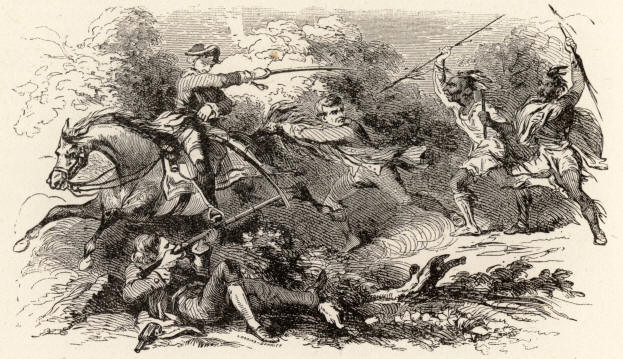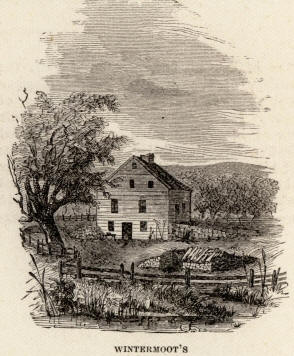Wyoming Valley Massacre
|
|
This Site:
|
Wyoming Valley Massacre. Among the Connecticut settlers in the Wyoming Valley were some Scotch and Dutch families from the Mohawk Valley. About thirty of them, suspected of being Tories, were arrested at the beginning of the war, and sent to Connecticut for trial. They were released for want of evidence, returned to the Mohawk, joined the Tory partisan corps of Johnson and Butler, and waited for a chance of vengeance on their persecutors. In June, 1778, a motley host of Tories and Indians, under the general command of Colonel Butler, gathered at Tioga, on the Susquehanna River. They entered the Wyoming Valley July 2. Among them were the vengeful Scotch and Dutch. Butler made his headquarters at the fortified house of Wintermoot, a Tory. Two full companies, out of 3,000 inhabitants, had been raised in the valley for the Continental army, and its only defenders were old men, brave women, tender youths, and a handful of trained soldiers. These, 400 in number, Colonel Zebulon Butler, assisted by Colonel Denison, Lieutenant-colonel Dorrance, and Major Garratt, led up the valley (July 3) to surprise the invaders at Wintermoot's. They were terribly smitten by Tories and savages in a sharp fight, and more than one-half were killed. Very soon 225 scalps were in the hands of the Indians.
|
|
|
||
|
|
Site Copyright 2003-2018 Son of the South. For Questions or comments about this collection, contact: paul@sonofthesouth.net |
|
|
Are you Scared and Confused? Read My Snake Story, a story of hope and encouragement, to help you face your fears. |
||

 A
few of the smitten ones escaped, with Colonel Denison, to Forty
Fort, just above Wilkesbarre, and Butler himself fled to Fort
Wilkesbarre. In the former, families for miles around had taken
shelter. The night that followed was full of horrors. Prisoners were
tortured and murdered, and the fugitives were in continual fear of
death. Unexpectedly to all, the leaders of the invaders offered
humane terms of surrender to the inmates of Forty Fort, and they
retired to their homes in fancied security, while Colonel Butler
left the valley. In disobedience of his commands, the Indians spread
over the valley before sunset (July 4), and when night fell they
began the horrid work of plundering, murdering, and burning. The
blaze of twenty dwellings lighted up the valley and the neighboring
mountains at one time. In almost every house and every field the
murderous work was performed. When the moon rose, the terrified
survivors of the massacre fled to the Wilkesbarre Mountains and to
the morasses of the Pocono beyond. In that dreadful wilderness
called the "Shades of Death" many women and children perished. Those
who survived made their way eastward until they reached their native
homes in Connecticut. Five miles and a half above Wilkesbarre, near
the pleasant village of Troy, stands a monument, constructed of hewn
blocks of granite, erected in commemoration of the slain in the
battle who were buried at that spot. Upon two marble tablets are the
names of those who fell, as far as could be ascertained, and also of
those who were in the battle and survived. This monument was not
completed until more than sixty years after the sad event. See
Campbell's Gertrude of the Wyoming.
A
few of the smitten ones escaped, with Colonel Denison, to Forty
Fort, just above Wilkesbarre, and Butler himself fled to Fort
Wilkesbarre. In the former, families for miles around had taken
shelter. The night that followed was full of horrors. Prisoners were
tortured and murdered, and the fugitives were in continual fear of
death. Unexpectedly to all, the leaders of the invaders offered
humane terms of surrender to the inmates of Forty Fort, and they
retired to their homes in fancied security, while Colonel Butler
left the valley. In disobedience of his commands, the Indians spread
over the valley before sunset (July 4), and when night fell they
began the horrid work of plundering, murdering, and burning. The
blaze of twenty dwellings lighted up the valley and the neighboring
mountains at one time. In almost every house and every field the
murderous work was performed. When the moon rose, the terrified
survivors of the massacre fled to the Wilkesbarre Mountains and to
the morasses of the Pocono beyond. In that dreadful wilderness
called the "Shades of Death" many women and children perished. Those
who survived made their way eastward until they reached their native
homes in Connecticut. Five miles and a half above Wilkesbarre, near
the pleasant village of Troy, stands a monument, constructed of hewn
blocks of granite, erected in commemoration of the slain in the
battle who were buried at that spot. Upon two marble tablets are the
names of those who fell, as far as could be ascertained, and also of
those who were in the battle and survived. This monument was not
completed until more than sixty years after the sad event. See
Campbell's Gertrude of the Wyoming.